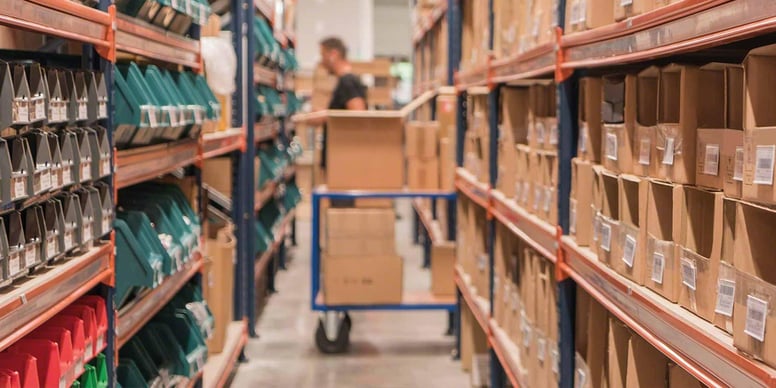Logistics is at the heart of the economic and commercial challenges facing today’s businesses. A fully optimized and correctly managed logistics warehouse ensures you offer the highest quality of service for greater customer satisfaction. Logistics, therefore, are decisive factor for the competitiveness of your enterprise. In this article you’ll find out everything you need to know about warehouses, what they’re used for, and what benefits they bring.
Warehouses: what they look like and what they do
A warehouse is much more than just a building in which goods are stored. Read on to find out what it is and how it’s different from a logistics platform.
What is a warehouse?
A warehouse is a space in which various goods are stored; but it's designed to fulfil many other functions too, including:
- Reception and inspection of goods;
- Storage of products - individually, in boxes, or on pallets - in the storage zone;
- Wrapping of goods;
- Post manufacturing: labelling, packaging of goods;
- Loading/unloading products in/from vehicles.
To perform all these functions, the warehouse requires a range of equipment and resources, including:
- Storage shelves;
- Storage racks: storage space designed to hold heavy and bulky goods;
- Storage cabinets: closed storage, perfect for storing goods that require more security (e.g. toxic or high-value products);
- Floor space.
Containers and bulk storage areas may also be found outside the building.

Difference between a warehouse and a logistics platform
A logistics platform is used in a mode of logistics known as “cross docking”.
The principal characteristic of cross docking is that no storage space is needed. With this difference in mind, it's immediately clear how a logistics platform differs from a warehouse.
Be careful not to confuse logistics platforms with warehouses:
- In a warehouse: goods are stored for more than 24 hours. There are storage racks and shelves, and all the necessary equipment for storing and processing the goods.
- In a logistics platform: the goods are only passing through and do not remain on the facility for more than 24 hours, the time necessary for them to be grouped and ungrouped.
These two types of logistics facility serve different yet complementary purposes. In sectors such as large-scale retailing, it's common to find a logistics warehouse zone and a logistics platform (cross docking) zone within the same facility.
The advantages of a logistics warehouse
The advantages offered by a warehouse are directly related to how well it is managed. The warehouse is an essential link in the supply chain, so if it's not well managed, it negatively impacts the whole chain.
The warehouse plays a key role in regulating and accelerating workflows. So, instead of just listing the advantages, we’ll tell you what you need to get the most out of your warehouse.
Optimal product track and trace
An optimized warehouse goes hand in hand with process automation in the form of labelling, the use of a Warehouse Management System (WMS) or the implementation of robotics systems to speed up order picking.
By attaching an electronic tag to the various items and packages, we can monitor the transit of products through the storage zone during the preparation of orders, and then track their progress after shipping, from their departure to their arrival at the end recipient.
Packages are “flashed” at each stage on their journey, giving you a precise view of their condition and location.
Track and trace data can be used to continuously improve the process itself: as items are flashed at each stage, you can accurately measure the length of each stage.
Using WMS software you can optimize other steps as well: automation of order picking, for example, or reorganization of storage space according to seasonal trends or activity spikes.
Shorter delivery times
In today’s market, it isn’t enough just to shift a lot of product. To be successful, you have to be able to deliver the goods on time. And delivery times are getting shorter all the time in an attempt to satisfy increasingly impatient consumers.
In e-commerce, it's not uncommon for companies to delay delivery of goods following an increase in orders.
It’s a phenomenon consumers know well: we’ve all received an e-mail informing us that due to an increase in the volume of orders our item would take longer to process and its delivery would be delayed etc.
This may not seem serious, but when placing an order consumers often opt for the e-commerce site offering the fastest delivery times.
Besides the problem of delivery times and the exceptional situations that can cause delays, there is also a real need for companies that are renewing their product ranges more and more frequently and offering more and more promotions to optimize their warehouse logistics.

For stock to flow smoothly and reach recipients quickly, it's essential to improve your logistics flows.
Here again, WMS software makes all the difference. WMS allows you to optimize:
- How goods are categorized and stored;
- Order picking sequences;
- The allocation of tasks around the different employees.
Used in conjunction with a goods to man robotics solution for automated stock management, WMS helps you simplify and speed up processes, for example by reducing unnecessary legwork.
And that means you can also:
- Accurately forecast increases or decreases in workflows;
- Reduce order response times;
- To confine activity spikes to limited time frames.
All this makes it possible to speed up processing and therefore delivery, even in just-in-time mode. And that can really increase your sales.
Fully automated shipping
A logistics warehouse optimized with WMS software, an automated goods to man picking system and electronic labelling helps reduce the need for human intervention in processes with little added value.
Everything is done by robots and controlled by the operators on site.
Shipping is automated, enabling:
- Reduced costs;
- Faster processing of orders and delivery of goods.
Improved ROI
Optimizing your storage space and processes directly affects your ROI. More goods can be received and processed in your warehouse, with shorter processing and shipping times. These improvements allow you to:
- Process greater volumes of orders
- Reduce errors;
- Increase your competitiveness;
- Increase the quality of your services;
- Reduce costs;
- Improve employee productivity.
All these factors contribute to a significant increase in business volume.
Benefits for employees
Process automation and optimization simplifies the work of employees, and allows them to be more productive and work in better conditions. Which improves their well-being, safety and job satisfaction.
The warehouse is a key element in the supply chain. More than just a storage building, it acts as a kind of valve. Well managed, its positive impact on the entire chain is significant, improving ROI and the satisfaction of customers and employees.



Laisser nous votre commentaire